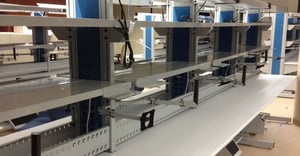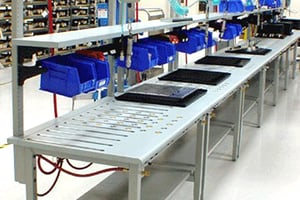Casework serves as the framework that orchestrates efficiency, organization and safety within a laboratory environment.
While there are different types of casework available to you to meet your storage needs, from general wall cabinets to specialized storage solutions like chemical cabinets, one of the most important decisions you’ll be faced with is the material used to construct the casework.
Four of the most popular materials used to build casework in laboratories include:
- High pressure laminate
- Wood
- Steel
- Stainless steel
Let’s dive into the advantages and disadvantages of each type, as well as some other considerations you should keep in mind when choosing the right product for your lab.
High Pressure Laminate
Manufacturers construct high pressure laminate casework by applying a melamine resin over decorative surface paper, followed by bonding this to a core of kraft papers impregnated with phenolic resin.
surface paper, followed by bonding this to a core of kraft papers impregnated with phenolic resin.
One of the biggest benefits to using high pressure laminate, or HPL laminate, for your casework is that you can create a more decorative, customized look that is also functional for storage purposes. However, high pressure laminate isn’t recommended in a lot of environments where harsh conditions exist.
Advantages of high pressure laminate:
- Lower in price when compared to other materials
- Up to moderate duty for wear and tear
- Designer looks available
- Can be used in environments where heat sources are present (but cannot be exposed to extreme heat above 275 degrees F)
Disadvantages of high pressure laminate:
- Low bacterial resistance
- Low chemical resistance
- Low corrosive resistance
- Low fungal resistance
- Low water and moisture resistance
- Low scratch resistance
Ideal workspace: Testing and technology labs
Wood
Wood casework is the traditional choice for many workspaces. Yet while attractive, wood cabinetry can be more susceptible to wear and tear than other materials. It can be a great choice for woodworkers, furniture manufacturers and teaching classrooms, but may not be ideal for certain types of labs.
Advantages of wood:
- Moderate duty for wear and tear
- Attractive look, adding warmth to a space
- Mid-price when compared to other materials
- Easy to customize to fit certain spaces
- Can withstand corrosive applications in moderation
Disadvantages of wood:
- Low bacterial resistance
- Low chemical resistance
- Low fungal resistance
- Low water and moisture resistance
- Low scratch resistance
- Can dent easily on impact
Ideal workspace: Beauty product labs, basic product testing, dry research and technology labs
Steel
Steel casework is usually constructed using heavy duty, 12-gauge steel. It can have a powder coat finish, which helps prevent cracking, peeling and chipping. The power coat is also abrasion, corrosion and chemical resistant.
finish, which helps prevent cracking, peeling and chipping. The power coat is also abrasion, corrosion and chemical resistant.
This level of protection makes steel casework a great choice for harsh environments.
Advantages of steel:
- Heavy duty
- Moderate bacterial resistance
- Moderate chemical resistance
- Moderate scratch resistance
- Moderate bacterial resistance
- High fungal resistance
- High water and moisture resistance
- Mid-price when compared to other materials
- Resistant to germs
- Easy to care for (only warm water and soap needed, but commercial cleaners ok as well)
- Heat resistant
Disadvantages of steel:
- Can dent upon impact
- Can customize with paint colors, but will increase price by 15% to 20%
- Not resistant to all chemicals (sodium hydroxide, chloride, sulfide and some acids)
Ideal workspace: Chemical, clean room, dental, ESD, electronics, industrial testing, photographic dark room, product testing, research and development, school and scientific labs
Stainless Steel
Stainless steel cabinets and casework is constructed of low carbon steel that is comprised of chromium and nickel. These materials offer resistance to rust and corrosion, and because stainless steel is non-porous, liquids cannot penetrate it.
Advantages of stainless steel:
- Moderate to heavy duty
- Moderate chemical resistance
- Moderate corrosive resistance
- High fungal resistance
- High water and moisture resistance
- High heat resistance (continuous exposure above 1500 degrees F)
- Environmentally-friendly material since stainless steel is a recyclable material
- High strength duplex grades
Disadvantages of stainless steel:
- Low scratch resistance
- Dents easily on impact
- Higher price when compared to other materials
- Not resistant to a few chemicals (acetic acid, phosphoric acid, sulfuric acid, sodium hydroxide)
- Can experience some discolor with prolonged high temperatures
Ideal workspace: Animal research, autopsy, biological science, chemical, clean room, food testing, hospital, medical and pharmaceutical labs, applications with open flames
Other Casework Considerations
When purchasing casework, it’s essential to look beyond only the material and consider other factors as well to ensure this important laboratory furniture meets your specific needs and complements your space effectively. Here are some additional considerations to keep in mind.
Safety Factors
If you operate a laboratory, cabinets you can purchase at an office supply store or online may not have the qualities you need to safely hold your supplies, chemicals and other materials.
Lab casework should always meet SEFA 8 performance standards for safety, durability and structural integrity. The Scientific Equipment and Furniture Association produces an international standard that is designed to ensure high-quality lab casework by examining various aspects like strength, structural integrity, hinge and drawer hardware strength, and chemical resistance.
If you work in a lab environment where ESD, or electrostatic discharge, could impact safety or product integrity, it’s important to consider lab casework that offers customizations like ESD laminate shelving.
ESD refers to the sudden flow of electricity between two electrically-charged objects, typically caused by contact, an electrical short or a potential difference between them. ESD can be damaging to electronic components and devices, since the discharge can disrupt or damage their sensitive circuits.
Where Casework Is Made
Purchasing quality lab casework helps ensure a longer lifespan, especially if you are placing it in a high-use area. American-manufactured casework has a reputation for being held to higher standards and therefore can withstand harsher conditions longer when used properly.
Even though you think you may be getting a better deal by purchasing imported products at a lower price, if the quality is lower as well, this decision will likely end up costing you more in the long run since you will have to more frequently replace your casework.
Be sure to ask any manufacturer you’re considering about the standards they are using. For example, if you’re looking at metal lab casework, ask questions about gauge of steel, paint processes, types of hinges and how the casework is constructed. For wood casework, inquire about the type of wood, hinge types and finishes used on the final product.
Available Customizations
Choosing casework for your lab should be a customizable experience, which will better allow you to meet the needs of your specific lab. It’s important to work with a casework manufacturer that can customize your casework based on your unique requirements.
Some customization opportunities include:
- Shelving (laminate, steel, stainless steel, wire, split shelf frame)
- Electrical (power cord access, mounting abilities)
- Lighting (overhead or lighting inside the casework)
- CPU (fixed or adjustable CPU holders)
- Drawers (extensions, roller bearing slides, cup handles)
- Casters (for mobile use)
- Other add ons for increased organization (swing arms, cup holders, peg boards)
Manufacturing Lead Time
Even though you may think you have the perfect casework design, if you can’t access your order for months, your workflow and project timelines could be impacted.
Most casework is made to order, so it’s important to allow for the time it takes from the release of your order to production of your product. One area that clients don’t always take into account is the shipment time, however. If a product is being constructed across the country, it could take an additional week or more to receive your order. If you’re ordering from an overseas supplier, it could take even longer due to customs issues and shipment time.
If you’re working on a tight deadline, it’s critical to partner with a lab casework manufacturer that can work with you on lead time to ensure your own production or lab schedule remains intact.


